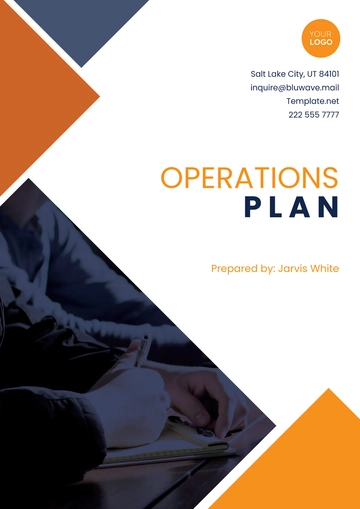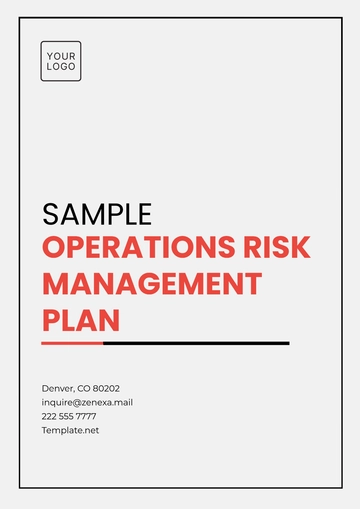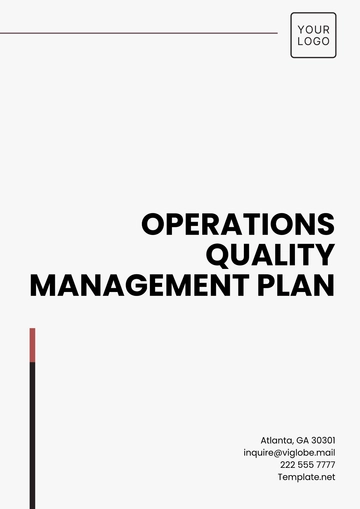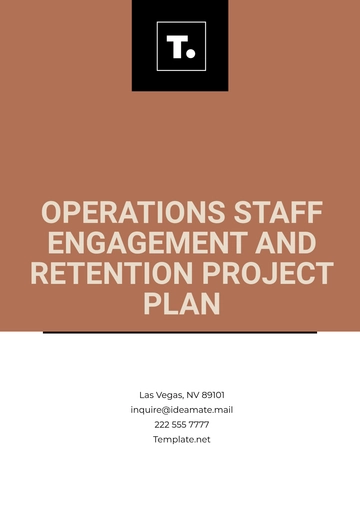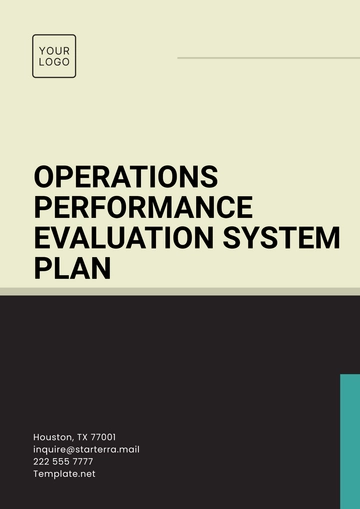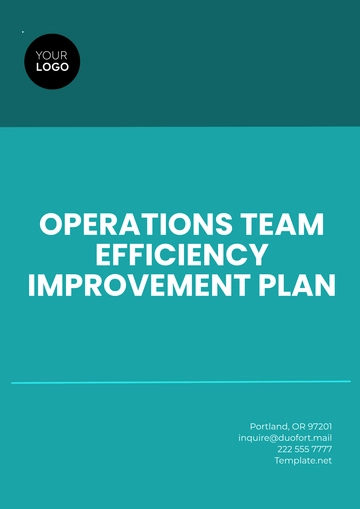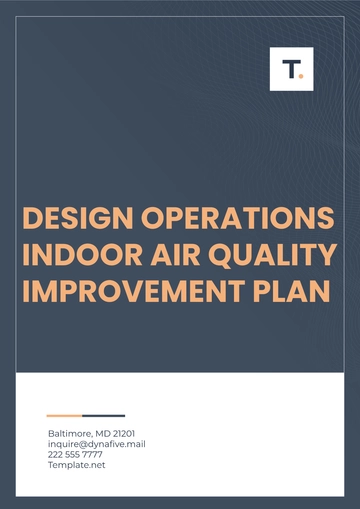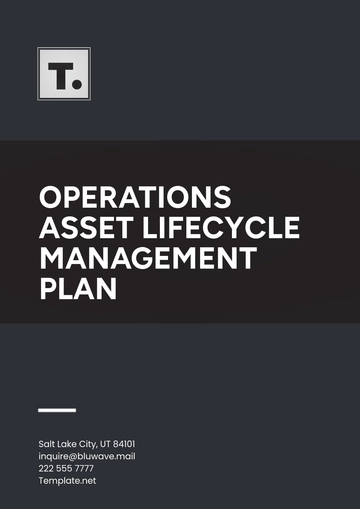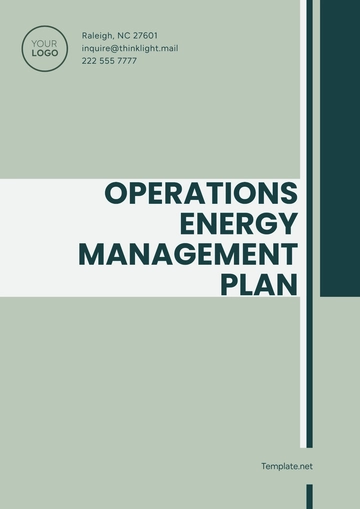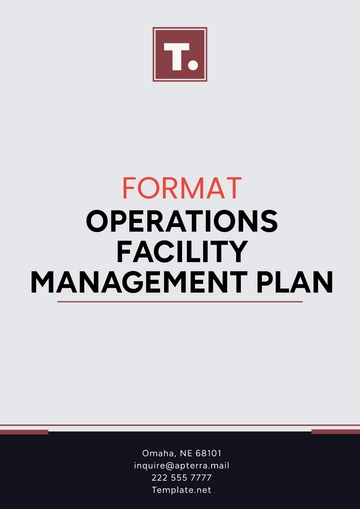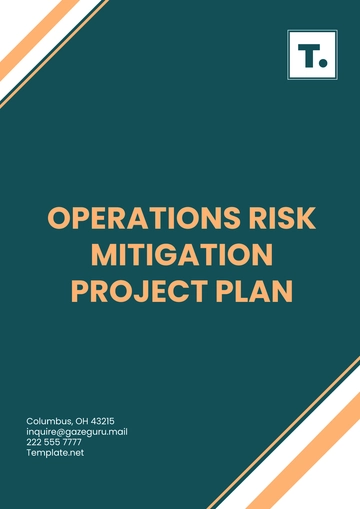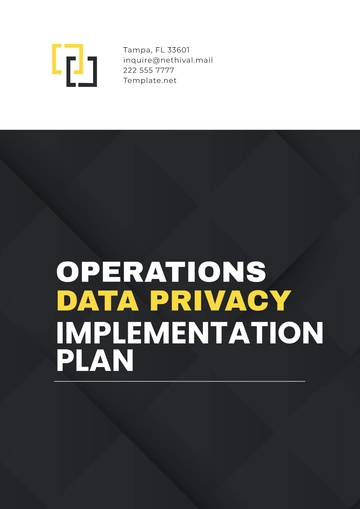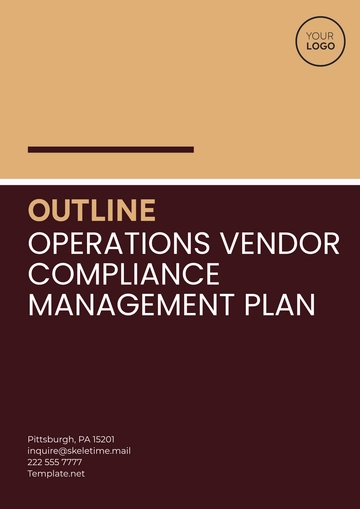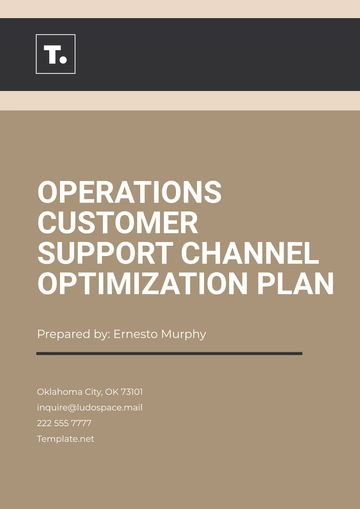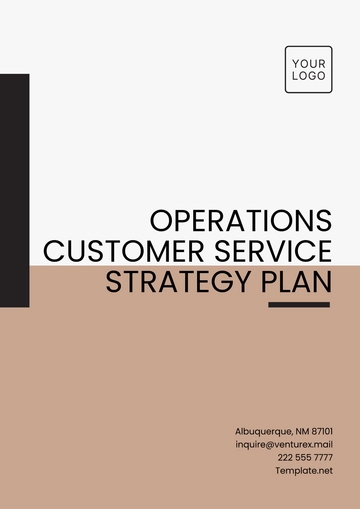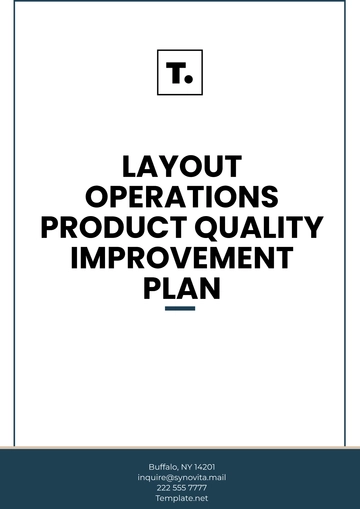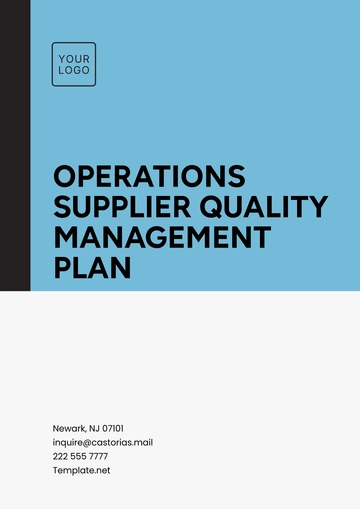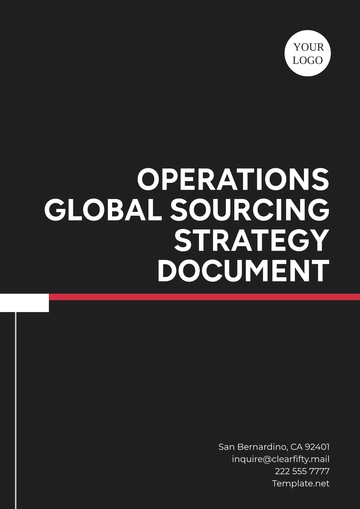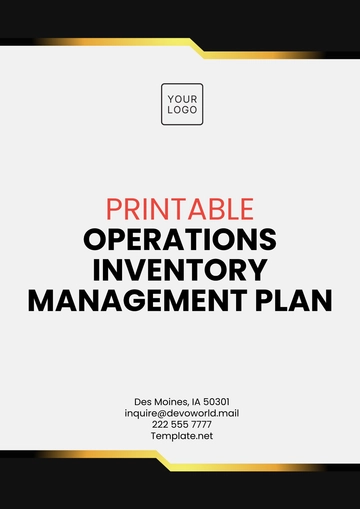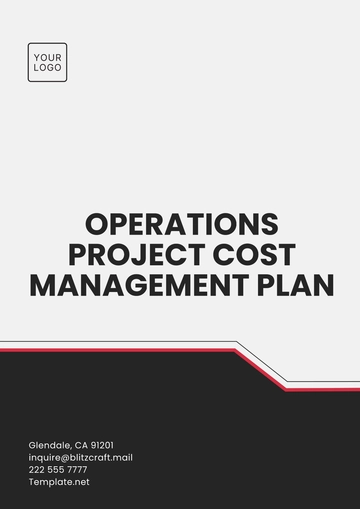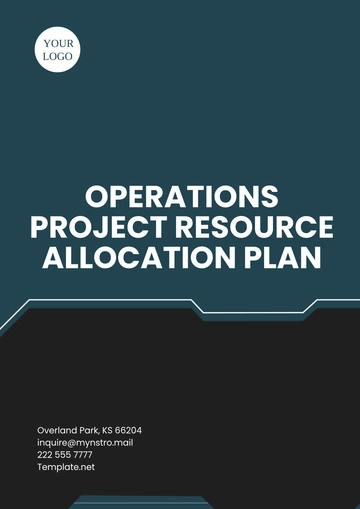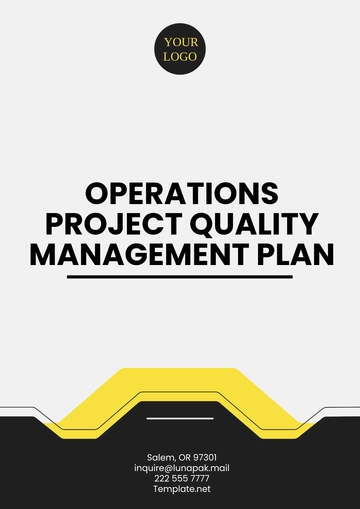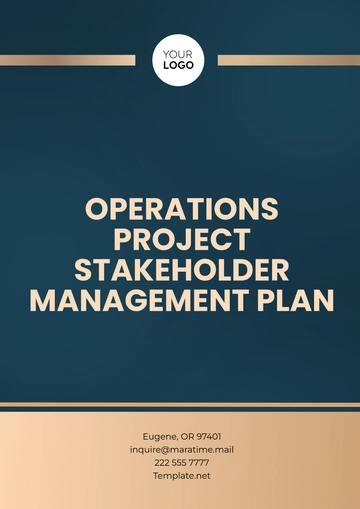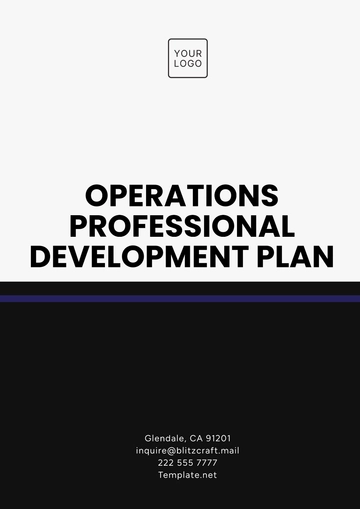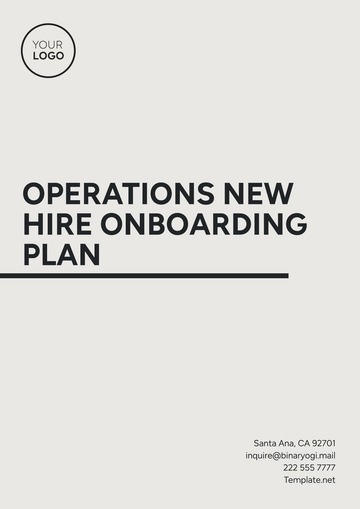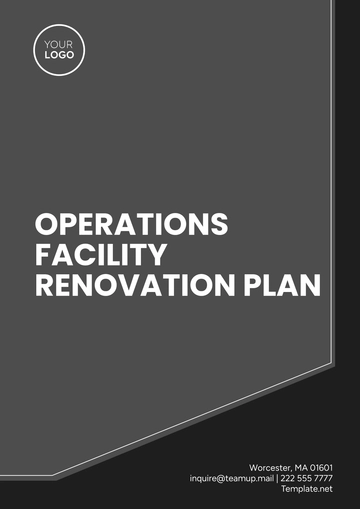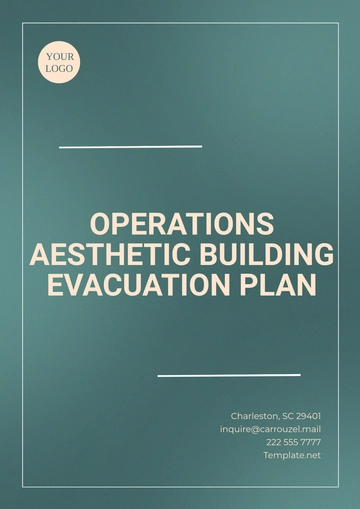Free Health & Safety Operations Plan
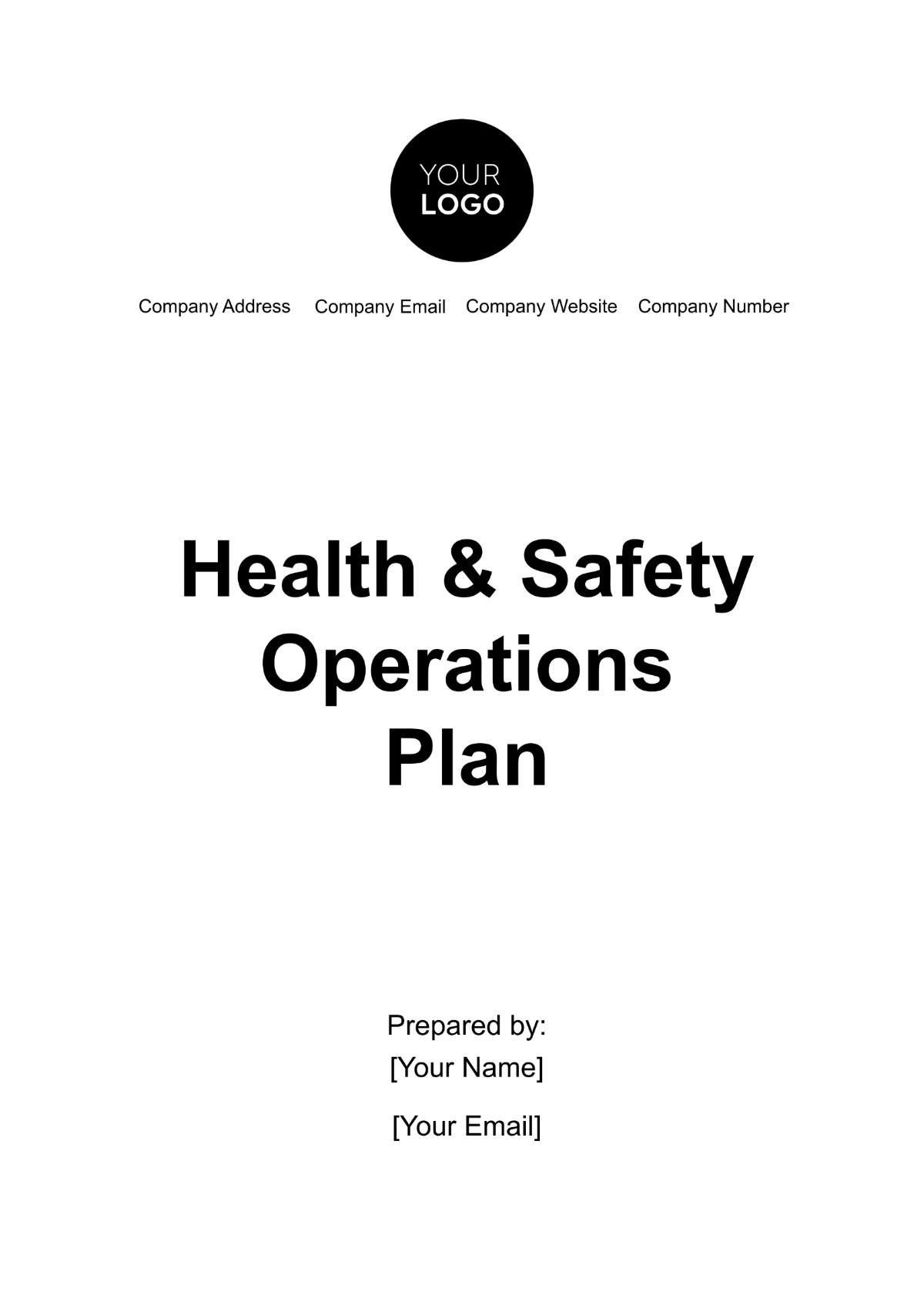
I. Introduction
The Health & Safety Operations Plan is a crucial component of our commitment to maintaining a safe and healthy work environment for all employees at [Your Company Name]. This plan outlines the procedures and protocols designed to prevent accidents, minimize risks, and ensure compliance with federal and state safety regulations. By implementing these measures, we aim to foster a culture of safety that protects our workforce and promotes well-being across our operations.
Our approach to health and safety is guided by the Occupational Safety and Health Administration (OSHA) standards and best practices. We recognize that safety is an ongoing process that requires continuous improvement, regular training, and active participation from all team members. This plan includes detailed protocols for emergency response, risk assessment, incident reporting, and ongoing safety training. It is our goal to create an environment where safety is prioritized, and every employee is empowered to contribute to a safer workplace.
II. Objectives
This section presents the key objectives of the Health & Safety Operations Plan. It defines the strategic goals we aim to achieve in our efforts to enhance workplace safety. Each objective is designed to support our overarching mission of fostering a secure and compliant work environment. This segment sets the stage for understanding how these goals drive our safety initiatives and contribute to our commitment to health and safety within the organization.
To establish protocols for maintaining health and safety standards.
To identify potential hazards and implement control measures.
To ensure compliance with applicable health and safety regulations.
To promote a culture of safety and responsibility.
III. Organizational Roles and Responsibilities
This section delineates the specific roles and responsibilities associated with health and safety within our organization. By clearly defining these roles, we aim to ensure that everyone understands their part in maintaining a safe work environment. The Health & Safety Manager, Supervisors, Employees, and Visitors each have distinct responsibilities that contribute to our overall safety objectives.
Understanding these roles is crucial for effective implementation of safety protocols and fostering a culture of accountability. Each role is designed to support our commitment to safety, from overseeing protocols and conducting risk assessments to adhering to guidelines and reporting hazards. This structured approach ensures comprehensive management of health and safety across all levels of our organization.
Role | Responsibilities |
|---|---|
Health & Safety Manager | Oversee implementation of safety protocols, conduct risk assessments, and report incidents. |
Supervisors | Ensure team compliance with safety procedures, provide training, and monitor workplace conditions. |
Employees | Adhere to safety guidelines, report hazards, and participate in training programs. |
Visitors | Follow safety instructions and report any unsafe conditions observed. |
IV. Risk Assessment and Hazard Identification
Effective risk assessment and hazard identification are fundamental components of our Health & Safety Operations Plan. This section outlines the procedures for identifying potential hazards in the workplace, evaluating associated risks, implementing control measures, and regularly reviewing and updating assessments.
Identify Potential Hazards: The first step involves a comprehensive evaluation of the workplace to identify potential hazards. This includes physical hazards such as machinery, chemicals, and ergonomics, as well as procedural and environmental risks. Regular inspections, employee feedback, and industry best practices are used to uncover hazards that could impact health and safety. Identifying hazards proactively helps in addressing potential issues before they result in incidents or injuries.
Evaluate Risk Associated with Each Hazard: Once hazards are identified, the next step is to assess the risk they pose. This involves analyzing the likelihood of an incident occurring and the potential severity of the outcomes. Risk evaluation considers factors such as the frequency of exposure, the number of people potentially affected, and the effectiveness of existing controls. This process helps prioritize which risks need immediate attention and which can be managed with existing measures.
Implement Control Measures to Mitigate Risks: Based on the risk assessment, appropriate control measures are implemented to mitigate identified risks. These measures may include engineering controls (such as installing safety guards), administrative controls (such as modifying work procedures), personal protective equipment (PPE), and training programs. The goal is to reduce risks to acceptable levels, ensuring a safer working environment. Each control measure is selected based on its effectiveness and practicality in reducing the identified risks.
Regularly Review and Update Risk Assessments: Risk assessments are not static; they require regular review and updates to remain effective. Changes in the workplace, such as new equipment, processes, or personnel, can introduce new hazards or alter existing risks. Regular reviews ensure that risk assessments stay current and relevant, and that control measures are adjusted as needed. This ongoing process helps maintain a proactive approach to health and safety, adapting to evolving conditions and continuously improving workplace safety.
V. Emergency Procedures
This section outlines the critical steps to follow in the event of an emergency, ensuring a coordinated and effective response. Clear and timely actions are essential to safeguard the well-being of all personnel and visitors. The procedures detailed here provide a systematic approach to managing emergencies, including how to alert emergency services, evacuate safely, and account for everyone on-site.
Following these procedures will help minimize risks and ensure a prompt and organized response. By adhering to these guidelines, we aim to protect lives, maintain order during crises, and facilitate a swift resolution to any emergency situation that may arise.
In the event of an emergency, the following procedures should be followed:
Immediately notify emergency services (e.g., fire, medical) as required.
Evacuate the building using the nearest exit.
Assemble at the designated meeting point.
Account for all personnel and visitors.
Report any missing or injured individuals to emergency services.
VI. Training and Communication
Effective training and communication are essential to maintaining a robust health and safety program. This section outlines our approach to ensuring that all employees are well-informed and prepared to handle health and safety issues. We emphasize the importance of comprehensive training programs and continuous communication to foster a culture of safety and readiness.
To ensure comprehensive coverage, the following training programs will be implemented:
New Employee Orientation and Safety Training: Every new employee will undergo a thorough orientation that includes an introduction to our health and safety policies and procedures. This foundational training ensures that new hires are equipped with the knowledge needed to work safely from day one.
Regular Safety Drills and Emergency Response Practice: To reinforce safety procedures and ensure preparedness, we conduct regular safety drills and emergency response practices. These drills simulate various emergency scenarios, such as fires, chemical spills, and medical emergencies, allowing employees to practice their responses in a controlled environment. Regular participation in these drills helps employees remain calm and effective during actual emergencies and ensures that safety procedures are executed correctly.
Specialized Training for High-Risk Tasks: Employees involved in high-risk tasks or operating specialized equipment receive targeted training tailored to their specific roles. This specialized training addresses the unique hazards associated with these tasks and provides detailed instructions on safe practices and emergency procedures.
Ongoing Communication About Safety Updates and Incidents: Continuous communication is crucial for keeping all employees informed about safety updates, changes in procedures, and recent incidents. Regular safety meetings, bulletins, and digital communications are used to disseminate important information and reinforce safety messages.
By implementing these training and communication strategies, we aim to create a knowledgeable and responsive workforce, committed to maintaining a safe and secure work environment.
VII. Compliance and Monitoring
Ensuring compliance with health and safety regulations is a critical component of our operations. This section outlines the methods and practices we employ to adhere to all relevant regulations and continuously monitor our safety performance. Our approach includes regular audits, effective reporting mechanisms, ongoing performance monitoring, and prompt corrective actions.
Regular Audits and Inspections: To maintain high standards of health and safety, we conduct regular internal audits and inspections. These audits involve a comprehensive review of our safety practices, policies, and procedures to ensure they align with regulatory requirements. Inspections are performed periodically to assess workplace conditions and identify any potential hazards or areas for improvement. The results of these audits and inspections provide valuable insights that guide our safety management efforts and help ensure ongoing compliance.
Internal and External Reporting Mechanisms: We have established robust reporting mechanisms to facilitate internal and external communication regarding safety issues. Internally, employees are encouraged to report safety concerns, incidents, and near-misses through designated channels. Externally, we comply with regulatory requirements by submitting necessary reports to relevant authorities. These reporting mechanisms ensure transparency, facilitate timely resolution of safety concerns, and support our commitment to regulatory compliance.
Continuous Monitoring of Safety Performance: Continuous monitoring is essential for assessing the effectiveness of our health and safety programs. We track safety performance metrics, such as incident rates, near-miss occurrences, and compliance with safety procedures. This ongoing monitoring allows us to identify trends, measure the effectiveness of implemented controls, and make data-driven decisions to enhance safety performance.
Implementing Corrective Actions for Non-Compliance: When non-compliance issues are identified, whether through audits, inspections, or reporting mechanisms, corrective actions are promptly implemented. This involves addressing the root causes of non-compliance, making necessary adjustments to policies or practices, and ensuring that all issues are resolved effectively. Our commitment to corrective action helps prevent recurrence and strengthens our overall safety management system.
VIII. Conclusion
The Health & Safety Operations Plan is designed to create a secure and compliant work environment by establishing clear protocols, responsibilities, and procedures. By implementing comprehensive training, rigorous risk assessments, and regular monitoring, we aim to ensure that all employees understand their roles in maintaining safety and are well-prepared to handle emergencies. This plan reflects our commitment to meeting and exceeding health and safety regulations, fostering a culture where safety is a top priority.
Continual improvement is integral to our approach, and we are dedicated to regularly reviewing and updating our practices to adapt to new regulations, technologies, and workplace changes. Through ongoing training, effective communication, and prompt corrective actions, we strive to enhance our safety performance and address any potential issues proactively. Our goal is to provide a safe and healthy work environment where every team member can perform their duties with confidence, knowing that their well-being is safeguarded. By adhering to the principles outlined in this plan, we contribute to the overall success and safety of our organization.
- 100% Customizable, free editor
- Access 1 Million+ Templates, photo’s & graphics
- Download or share as a template
- Click and replace photos, graphics, text, backgrounds
- Resize, crop, AI write & more
- Access advanced editor
Ensure workplace safety with our Health & Safety Operations Plan Template from Template.net. Fully editable and customizable, this template helps you develop a comprehensive plan for managing health and safety protocols. Easily editable in our Ai Editor Tool, customize each section to align with your organization’s safety standards, ensuring a secure and compliant work environment.
You may also like
- Finance Plan
- Construction Plan
- Sales Plan
- Development Plan
- Career Plan
- Budget Plan
- HR Plan
- Education Plan
- Transition Plan
- Work Plan
- Training Plan
- Communication Plan
- Operation Plan
- Health And Safety Plan
- Strategy Plan
- Professional Development Plan
- Advertising Plan
- Risk Management Plan
- Restaurant Plan
- School Plan
- Nursing Home Patient Care Plan
- Nursing Care Plan
- Plan Event
- Startup Plan
- Social Media Plan
- Staffing Plan
- Annual Plan
- Content Plan
- Payment Plan
- Implementation Plan
- Hotel Plan
- Workout Plan
- Accounting Plan
- Campaign Plan
- Essay Plan
- 30 60 90 Day Plan
- Research Plan
- Recruitment Plan
- 90 Day Plan
- Quarterly Plan
- Emergency Plan
- 5 Year Plan
- Gym Plan
- Personal Plan
- IT and Software Plan
- Treatment Plan
- Real Estate Plan
- Law Firm Plan
- Healthcare Plan
- Improvement Plan
- Media Plan
- 5 Year Business Plan
- Learning Plan
- Marketing Campaign Plan
- Travel Agency Plan
- Cleaning Services Plan
- Interior Design Plan
- Performance Plan
- PR Plan
- Birth Plan
- Life Plan
- SEO Plan
- Disaster Recovery Plan
- Continuity Plan
- Launch Plan
- Legal Plan
- Behavior Plan
- Performance Improvement Plan
- Salon Plan
- Security Plan
- Security Management Plan
- Employee Development Plan
- Quality Plan
- Service Improvement Plan
- Growth Plan
- Incident Response Plan
- Basketball Plan
- Emergency Action Plan
- Product Launch Plan
- Spa Plan
- Employee Training Plan
- Data Analysis Plan
- Employee Action Plan
- Territory Plan
- Audit Plan
- Classroom Plan
- Activity Plan
- Parenting Plan
- Care Plan
- Project Execution Plan
- Exercise Plan
- Internship Plan
- Software Development Plan
- Continuous Improvement Plan
- Leave Plan
- 90 Day Sales Plan
- Advertising Agency Plan
- Employee Transition Plan
- Smart Action Plan
- Workplace Safety Plan
- Behavior Change Plan
- Contingency Plan
- Continuity of Operations Plan
- Health Plan
- Quality Control Plan
- Self Plan
- Sports Development Plan
- Change Management Plan
- Ecommerce Plan
- Personal Financial Plan
- Process Improvement Plan
- 30-60-90 Day Sales Plan
- Crisis Management Plan
- Engagement Plan
- Execution Plan
- Pandemic Plan
- Quality Assurance Plan
- Service Continuity Plan
- Agile Project Plan
- Fundraising Plan
- Job Transition Plan
- Asset Maintenance Plan
- Maintenance Plan
- Software Test Plan
- Staff Training and Development Plan
- 3 Year Plan
- Brand Activation Plan
- Release Plan
- Resource Plan
- Risk Mitigation Plan
- Teacher Plan
- 30 60 90 Day Plan for New Manager
- Food Safety Plan
- Food Truck Plan
- Hiring Plan
- Quality Management Plan
- Wellness Plan
- Behavior Intervention Plan
- Bonus Plan
- Investment Plan
- Maternity Leave Plan
- Pandemic Response Plan
- Succession Planning
- Coaching Plan
- Configuration Management Plan
- Remote Work Plan
- Self Care Plan
- Teaching Plan
- 100-Day Plan
- HACCP Plan
- Student Plan
- Sustainability Plan
- 30 60 90 Day Plan for Interview
- Access Plan
- Site Specific Safety Plan
